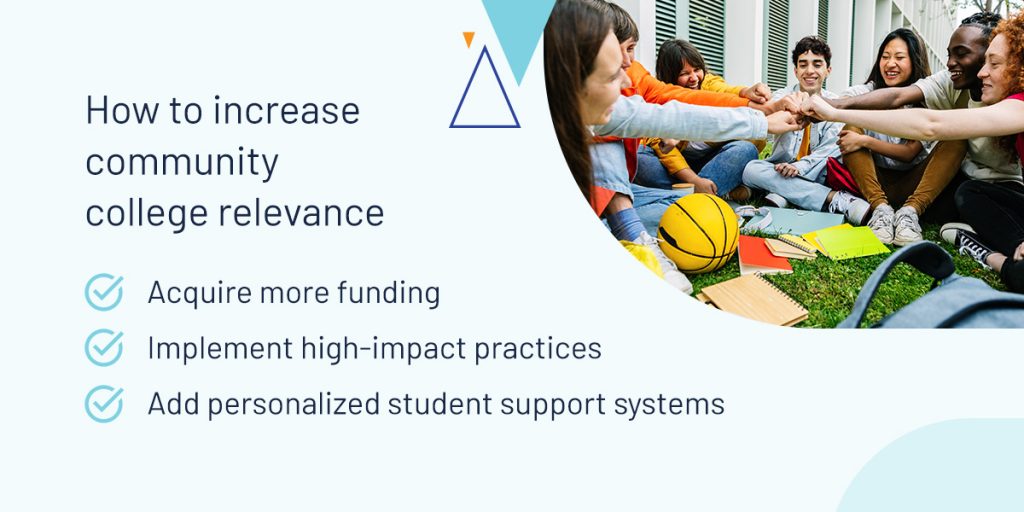




Community colleges provide a vital bridge to professional development and attaining higher education. However, these institutions face significant obstacles that make improving their relevance challenging. While community colleges work to give each student an enriching experience, they must discover new ways to engage and retain students.
Knowing how to increase enrollment at community colleges can help improve college relevance and boost student engagement and retention. Keep reading to discover the challenges facing community colleges and how to increase relevancy.
Community colleges play a significant role in workplace development across the country. These higher education institutions prepare students for careers by providing academic skills and program training. Students can obtain associate degrees that enable them to pursue their careers or enter four-year institutions with applicable credits already under their belt.
Nearly half of all students with a bachelor’s degree attended a community college previously. Additionally, recent findings highlight an associate degree can bring around 30 percent more earnings than a high school degree. This number jumps for those who use their community college experience to enter a four-year institution. While high school student graduates in the United States earn an annual average of $42,590, the average for a bachelor’s degree earning is $59,600. Those who pursue a master’s degree average nearly an additional $10,000 annually.
Many community college programs last two years or fewer and provide students with specific skills and training. The certificates that graduates obtain from vocational or technical programs show satisfactory work and are typically more affordable than traditional colleges or higher education institutions. This gives many students the opportunity to pursue higher education without needing to take out mass amounts of student loans.
As community colleges prepare for the future, they must develop curricula and initiatives that benefit transfer students, those entering the workforce, wealthy students, low-income students, and more to guide everyone to success. As these institutions aim to meet the needs of every student, some factors may get in the way.
Community colleges are facing low completion rates. Recent studies show that only around 40 percent of community college students finish their program within six years. This means that more than half of community college students do not complete their programs or transfer to another institution within six years of enrolling. Knowing how to improve student retention at community colleges works hand in hand with providing quality education to current students, but preserving access, granting access, and enhancing quality can take a while to accomplish.
Another challenge facing community colleges is accepting students who are not prepared to pursue collegiate-level academics. As little as one-third of high school seniors are equipped to meet the demands of higher education. There is often a vast gap in preparedness among community college students, which can make it challenging to ensure every student stays on track.
Lastly, community colleges are not experiencing as much collaboration or support as they need from other institutions. Many areas have multiple community colleges, and students could benefit from the abundance of course offerings. Despite how outside sources and collaboration could help students, many community colleges stand alone.

Increasing relevancy at community colleges can be simple if you use the proper techniques. Understanding trends in community colleges and strategies for increasing student enrollment can help community college administrators develop new ways to engage students and increase relevancy.
Consider these strategies for increasing relevancy at community colleges:
Community colleges offer a vital pathway to higher education. These institutions are typically less expensive than four-year higher education institutions, and they disproportionately serve students of color and low-income learners. The lower tuition costs provide academic opportunities that many students would otherwise not experience.
However, this means community colleges receive less education revenue per student. Four-year higher education institutions see just under $9,000 more per student, creating a $78 million gap. The gap between per-student revenue differs by state but still exists everywhere.
Less revenue means community colleges have less money to spend on creating enriching student experiences. Student persistence is tied to institution spending, and community college students lose valuable resources, advising services, emergency aid, and other resources when their institution does not have enough funding.
Implementing high-impact practices can boost community college completion rates. High-impact practices are effective teaching strategies your institution can use to connect students with their education. Studies have shown these practices to be beneficial for students by increasing engagement, persistence, and retention.
Examples of high-impact practices include:
By using these practices, higher education institutions have seen a 7 percent increase in persistence among students. High-impact practices encourage students to think deeply about their education. Some techniques enable students to compile a lengthy list of meaningful experiences, and others encourage students to engage with new perspectives and ideas. Either way, high-impact practices improve student outcomes and motivate students to feel more satisfied with their education.
Community colleges serve a wide range of students with unique backgrounds, and each has a different learning style. To fit every student’s needs, your institution should utilize personalized support. You can find many creative ways to increase college enrollment by personalizing student support systems.
These support systems can include accelerated study programs, writing centers, research offices, mentorship programs, and other resources that can aid students at your institution. You may offer internship and success offices for students looking to begin their careers and develop professionally. These programs provide comprehensive support and guide your students from the beginning of their academic journey through their graduation. These programs improve persistence and boost completion rates, aiding your mission to increase relevancy.
Because community colleges already offer career-specific training and skills, your students can benefit from having support to guide them to success. When students fall off track, your support staff can bring them back up to speed and ensure they have the necessary resources. When your students know they can find the assistance they need, they may feel more satisfied with their education and experience on campus.
The right higher education technology can amplify your educational impact, streamline collaboration, and enhance learning experiences. Digital solutions support engaging learning environments, enable personalized learning, and make learning a more collaborative process.
Quality technology solutions can also provide the deep insights you need to drive change across campus and support long-term initiatives. For example, you can collect and store student information to identify at-risk students early and provide proper intervention techniques to get them back on track. You could also leverage these insights to determine where you need to dedicate resources to strengthen a program, offer more experiences, implement a service, and more to drive constant, beneficial change.
Associate programs are an excellent opportunity to introduce learners to hands-on experience and teach essential skills students will need in future careers. This strategy aligns student learning with their interests and gives them a taste of the future, solidifying the need for higher education.
Diversify your programs to introduce job opportunities that are available post-graduation. For example, healthcare programs can partner with local clinics to provide real patient experiences. Teaching programs can collaborate with local school districts to empower learners to spend time in the classroom.
Along with granting real-world experience to your students, you can help them strengthen connections that could guide them to successful careers. For instance, a student applying for a teaching job at a local school district may be a more attractive hiring candidate if the student has spent time in similar classrooms, understands the school’s unique culture, and has experience working with the teachers and students in the building.
Redesigning program onboarding can increase and accelerate enrollment in your high-value programs. For example, connecting general studies to bachelor’s degrees or pre-major programs can create more meaningful student experiences. Redesigns can also enable your students to explore multiple learning and career paths to explore their interests and develop a success plan.
Use data analytics and student information to determine your high-value programs and identify pain points in your current infrastructure. Consider where students often fall behind and use curriculum mapping strategies to strengthen courses and programs. Be upfront with your students, and explain how they can use their education to enter the workforce or a four-year institution and help them access the resources and services they need to make these dreams a reality.
Watermark has spent the last 20 years crafting innovative solutions for higher education. We know insights inspire progress, and we want to help you maximize community college importance and increase relevancy by discovering new ways to engage your students. Our solutions support continuous improvement and give you more time to focus on what matters most — your students.
Watermark Student Success & Engagement is a software solution for engaging and retaining learners. With our software, you can use proven coaching methodologies to optimize student success. With Student Success & Engagement, you can turn insights into actions and transform your institution. Receive alerts when a student falls behind, and streamline the communication process to get them back on track. You can align your curriculum with student interests and goals with intuitive reporting and guided pathways.
Create personalized education paths and increase relevancy with Watermark. Request a demo of our solutions and discover what we can do for your institution.






























































































































































































































































































































































































Submit this form to schedule a meeting with one of our reps to learn more about our solutions. If you need customer support instead, click here.

